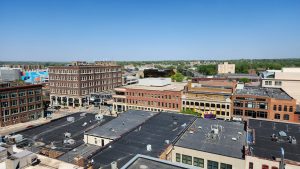With a booming population, growing economy, and a $773 million city budget to manage, South Dakota’s largest city faces an important decision. In 2026, Sioux Falls voters will elect their next mayor, a leader who may shape the city for the next eight years. The question is: Who is ready to do the job?
Due to a recent change by the South Dakota Legislature, the city’s elections will no longer be held in April. The new rules push the vote to either June or November, most likely June, with the possibility of a runoff a few weeks later if no candidate secures a majority.
As interest in the race builds, so does the list of potential candidates. But amid the buzz, a core question looms: What makes someone qualified to serve as the chief executive of a city with 1,400 full-time employees, 12 departments, and a rapidly expanding urban footprint?

Sioux Falls City Hall
This Isn’t a Council Seat, It’s a CEO Role
The Sioux Falls city charter says, “The executive and administrative power of the city shall be vested in a mayor.” Electing a mayor is different from choosing a legislator or city council member. This job isn’t about representing a district or debating policies. It’s about managing people, resources, and an increasingly complex operation. It’s about setting priorities, enforcing accountability, and delivering results in real time.
In many respects, the role resembles that of a private sector CEO. The 2025 city budget tops $773.2 million, covering public safety, roads, water systems, parks, libraries, housing initiatives, and more. Effective leadership means balancing that budget while investing for the future.
Experience Matters
For a city this size, the number one qualification in the eyes of many is executive experience. Preferably, the next mayor will have led or at least managed a part of a large organization, ideally one with hundreds of employees and a complex budget.
That hasn’t always been the standard. But perhaps it should be as our city grows both in size and complexity. In a perfect world, we might now look for someone in their 50s — seasoned, financially secure, and motivated by a desire to give back. Someone whose children are grown and who isn’t chasing the next promotion and is instead motivated to make an enduring positive impact in our community.
Why the Best Candidates Might Not Apply
One persistent obstacle is pay. The mayor of Sioux Falls earns significantly less than many of the professionals who report to them, and certainly less than comparable jobs in the private sector. That’s a quirk of public sector compensation that can deter high-caliber candidates. For top executives in business or healthcare, running for mayor could mean a significant pay cut.
If the city wants to attract its best and brightest, it may need to reconsider that equation. A more competitive salary for the mayor and for city council members, whose workload has grown beyond part-time expectations, would be a step toward treating local government like the serious enterprise it is.
Big Questions Await the Next Mayor
As campaign season approaches, voters should press candidates to articulate their vision. Key issues include:
- Smart Growth: Should Sioux Falls continue to pursue growth for growth’s sake, or instead start prioritizing quality-of-life factors?
- Decaying Neighborhoods and Struggling Schools: Central neighborhoods face mounting challenges, from aging infrastructure to multiple Title I schools where students’ basic needs often go unmet. How will the next mayor tackle these deep-rooted issues?
- Revisiting the City Charter: It’s been decades since Sioux Falls reviewed its foundational governing document. Is it time to revisit the charter, modernize outdated provisions and rethink the role of mayor?
One of those provisions worth reconsidering: the mayor’s seat on the city council. Most American cities run by a strong-mayor system operate under a separation-of-powers model where the mayor handles executive duties and the council handles legislation. Removing the mayor from the council would bring Sioux Falls in line with that best practice structure.

Sioux Falls is Growing
A Chance to Choose Boldly
The 2026 mayoral election is more than a routine contest. It’s a chance for Sioux Falls to choose bold, experienced leadership at a time of tremendous opportunity and growing complexity.
It’s also a chance to ask hard questions about the future: What kind of city do we want to be? And who is truly ready to lead us there?
With the right leader, Sioux Falls can reach its full potential. But first, voters must insist on experience, vision and a willingness to challenge the status quo. The next mayor won’t just manage our city; they’ll have the opportunity to establish its future.
The complexity and scale of modern municipal governance underscore the need for professional city managers appointed by elected officials—today’s challenges go far beyond merely casting a ballot.
“For a city this size, the number one qualification in the eyes of many is executive experience. Preferably, the next mayor will have led or at least managed a part of a large organization, ideally one with hundreds of employees and a complex budget.”
“In a perfect world, we might now look for someone in their 50s — seasoned, financially secure, and motivated by a desire to give back. Someone whose children are grown and who isn’t chasing the next promotion and is instead motivated to make an enduring positive impact in our community.
Well said, Joe. Ideal seasoned candidate could offer larger company management/business acumen, while removing the color of “future political aspirations” from their leadership decisions.
The charter gives to much power to the mayor. It represents authoritarian oligarchy more so than national government. Donald Trump proved he is above Rule of Law and made mockery of democracy. Returning to of, by, and for the people can start in 2026 with midterm and local elections. There must be checks and balances afforded by giving the council more power aside from the mayor or returning to city commissioners with equal votes. At present, contracts are awarded without competitive bid to insider contractors. One must ask; should it cost 3/4 of a billion dollars to manage a city with 200,000 citizens. Something is not right and can only be fixed by overhauling or replacing the city charter.
i do love reading these stories by Joe, he has so much knowledge and understanding of how city government works. I am taken back by his accomplishments. I also have actively have played a part of introducing new ways to govern the city, and Joe is right, it may be time to re-think the charter. While I oppose Joe in wanting to remove the mayor from the council, I would rather keep the mayor on the council, as such, so common folk can actually voice their concerns in front of the mayor during city council meetings. to some, many people never have the chance to talk to the mayor, so the city council is their only time to express themselves. For this reason, I say, the mayor must remain a member of the council.
I disagree, the Mayor alone does not have to much power. Like Joe, I do also love to study, and understand the charter. While the mayor has administrative power, the council as a whole, has “investigative powers”. While members of the council must speak to city officials by means of the mayors office, those same “city council membes” have the means to hold a investigative hearing, using subpoena power, to force those city officials, officers, employees to the witness stand. So, in my view, the two are equal.
For better transparency, I would much rather we change the charter to “elect” the City Attorney, while making him a member of the city council. This makes the city attorney much closer to the people, and I would like to see all legal opinions be transparent, posted on the city website.
And last, I think the ‘charter’ should be amended to change the dynamic of the composition of the council to include – 1 Mayor, a minimum of 2 At-Large Chairs, 1 City Attorney, and an Odd Number of Council District Chairs. Even with the mayor on the council, rather than 8 additional members, I believe the ‘elected city councilors must be made up of a Odd number, this takes away the mayors tie-breaking capabilities, thus, separates the mayor from any possible public vote.
Perhaps, even with the mayor on the council, but knowing he never has a tie-breaking vote, would go further in creating separation, while at the same time, force a little transparency into government.
But first, we need “Common Residents” to be elected to the City Council, who understand their role, in holding city government accountable, we need them to utilize charter section 2.09 more often.